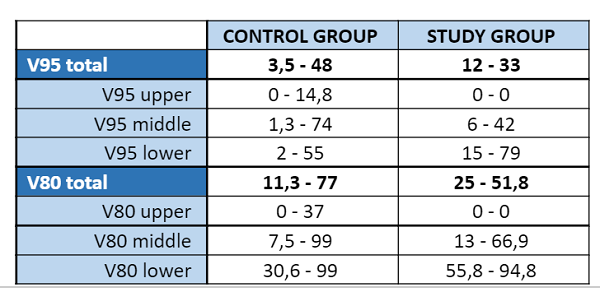Incidental vs elective irradiation of internal mammary chain
Laura Cardoso Rubio,
Spain
PO-1180
Abstract
Incidental vs elective irradiation of internal mammary chain
Authors: Laura Cardoso1, María Luisa Del Valle1, Laura Gómez1, Sofía Pena2, Álvaro Sanz3, María Isabel Garavís1, María Herrera1, Juan Francisco Gutiérrez1, Patricia Valencia1, Ana Casado1, Rocío Jaraíz1, Enrique Hurtado2, Pilar Alonso1, Daniel Rodríguez1, María Sánchez1, Ignacio Solís1, Patricia Diezhandino1
1Hospital Clínico Universitario de Valladolid, Radiation Oncology, Valladolid, Spain; 2Hospital Clínico Universitario de Valladolid, Medical Physics, Valladolid, Spain; 3Hospital Río Hortega , Medical Oncology, Valladolid, Spain
Show Affiliations
Hide Affiliations
Purpose or Objective
The specific impact of radiotherapy on internal mammary nodes (IMN) remains uncertain. As most IMN recurrences occurs between first and third intercostal space, we analyse the dose received in IMN and its anatomical sections in elective and no intentional IMN irradiation in patients treated with RT for breast cancer.
Material and Methods
Prospective study of breast cancer patients treated with breast-conserving surgery and whole breast radiotherapy (WBRT) from July 2020 to September 2021. Fifteen patients were treated only with WBRT (study group: S) and fifteen received elective IMN irradiation (control group: C). All patients were treated with tangential fields optimized using the field in field technique, without specific IMN field. We divided IMN volume in three anatomical sections, upper (1st to 2nd rib), middle (2nd to 4th rib), and lower section (4th to 5th rib). Therapeutic dose (V95) and significant dose with expected therapeutic efficacy (defined as V80) were assessed in total IMN and in every anatomical section.
Results
Median age was 57 (range: 42 to 78) years. Phenotype of tumors was luminal-A in 17, luminal-B in 8, HER2 in 2, and basal-like in 3. Left breast was affected in 9 patients in S and 9 in C. Central or internal quadrants were affected in 9 patients in S and in 5 in C. Median angulation of the internal tangential was 52° in S and 53° in C (p=0.79). The median percentage of the volume receiving therapeutic dose (V95) in IMN was 17% in the study group and 34% in the control group (p=0.36). V95 by anatomical sections: upper 11% (S) vs. <1% (C) (p=0.01), middle 40% (S) vs. 18% (C) (p=0.21), and lower 39% vs. 44% (p=0.62). The median percentage of volume receiving significant dose (V80) in IMN was 33% in S and 56% in C (p= 0.14); by anatomical sections: upper 5% (S) vs. 0% (C) (p=0.005), middle 71% (S) vs. 36% (C) (p=0.10), and lower 77% vs. 77% (p=1.0). Interquartile range as a measure of dispersion of received doses are presented in Table 1.

Table 1. IQR of the doses received by sections.

Conclusion
Even with elective irradiation, most patients did not achieve therapeutic doses in the entire IMN. Specifically, despite intentionality, we only found significant differences in the upper section. Dose received in IMN anatomical section shows a wide variation, probably related to anatomical factors.